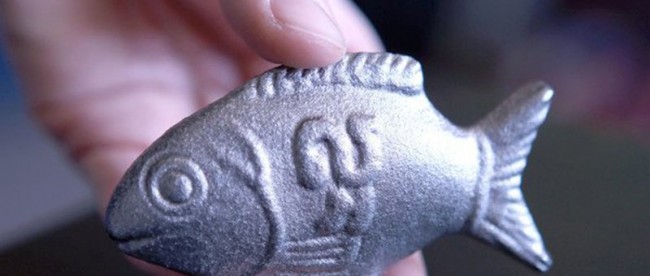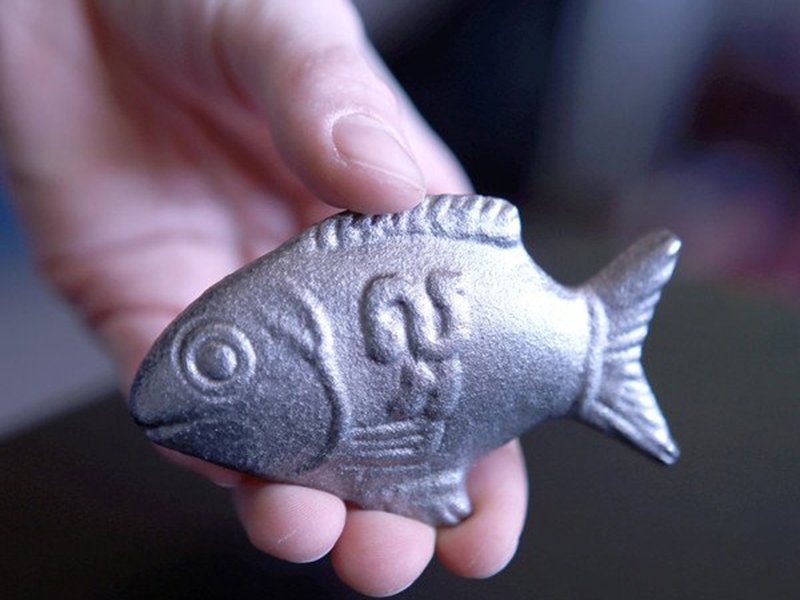The Lucky Iron Fish

Severe fatigue. Dizziness, chest pains, shortness of breath, and headaches. Pregnancy complications, including premature birth. Irregular heartbeats which can lead to more complicated heart problems. And worse. All of these are symptoms of untreated anemia, which the Mayo Clinic defines as “a condition in which you don’t have enough healthy red blood cells to carry adequate oxygen to the body’s tissues.” The most common form of anemia is iron deficiency anemia, caused by — you guessed it — not having enough iron in your body. To further rely on the Mayo Clinic, that’s because “your bone marrow needs iron to make hemoglobin,” the protein our red blood cells use to transport oxygen around our bodies. Not enough iron means not enough oxygen. That’s bad.
It’s also common, especially in developing areas where foods typically high in iron — eggs, meats, and leafy greens per Smithsonian — are rare. Take Cambodia, for example: per one study (pdf), 57% of children (under age 5) in urban areas and 64% in rural areas were anemic. Solving a wide-scale problem like that isn’t easy — and takes a little bit of luck.
Thankfully, we may have some luck to share. In the form of a fish.

That’s the fish pictured above, and you’ll immediate note that it’s not a real fish. It’s an iron ingot.
You can’t eat it, of course — swallowing a not-so-small lump of iron may help with anemia, but would cause a world of other problems. Instead, the fish are distributed to Cambodian families with the instructions to place it in a pot while cooking, as seen below (via here). As the meal cooks, a little bit of iron seeps into the food. Dr. Christopher Charles, the creator of the fish, told the BBC that the fish, used properly, “can provide 75% of an adult’s daily recommended intake of iron – and even more of a child’s.”

Seems simple enough — but when it comes to major health initiatives, simple isn’t enough. Making something easy to do doesn’t mean people will actually do it; we also have to find ways to encourage a change in behavior. And that’s where the fish — the Lucky Iron Fish, as it’s marketed — shines.
There’s really no scientific reason why the chunk of iron needs to be shaped like a fish; any iron ingot will do (and in fact, cast iron pans are also effective, albeit an expensive one). But when Dr. Charles and team distributed iron discs as part of their research phase, they ran into a problem. As Wikipedia explains, “the women were reluctant to use the chunk of iron while cooking” and adoption of the plain iron disc was very low. People were skeptical of the value of adding a slab of iron, even though the science behind it made sense, as adding the iron didn’t make intuitive sense to them.
So Charles and team looked for another way. The theory: maybe the people would be okay with adding a lucky talisman, even if the science there was lacking, as it meshed with their cultural beliefs. As it turned out, many communities in Cambodia believed certain types of fish to be lucky. Charles and team hoped to capitalize on this; that’s why the iron ingot is fish-shaped.
And there’s reason to believe that this design decision will make a big difference. In the summer of 2015, Slate reported on the results of Dr. Charles’ first trial run — and they’re promising. “Charles says they distributed 400 fish to five test communities and were surprised to find a 90 percent compliance rate for those who used it daily. Blood testing of the users showed a 50 percent decrease in the incidence of clinical iron deficiency anemia and an increase in users’ iron levels after nine months.”
The experiment is on-going and expanding. Per the Lucky Iron Fish website, more than 30,000 Fish have made their way to Asia, with more on the way.
Bonus fact: In Canada, engineering students participate in something called the “Ritual of the Calling of an Engineer,” a ceremony designed to instill within the students the ethical requirements associated with building major public works such as bridges. As part of the ceremony, the students are given an Iron Ring, to be worn on their dominant hand’s pinky finger, as a reminder of those requirements whenever they are drafting plans or signing off on them. (The Ritual was in response to a pair of bridge collapses in Quebec in the early 1900s, and legend has it that the first rings were made from the iron of those bridges, but that’s almost certainly untrue.)
From the Archives: Sweating Like a Pig: Pigs don’t sweat, so the saying “sweating like a pig” can’t be about them. It’s about iron. Here’s why.
Related: A pretty inexpensive cast iron skillet with great reviews. Yes, some iron will seep into your food. No, it probably isn’t dangerous.
